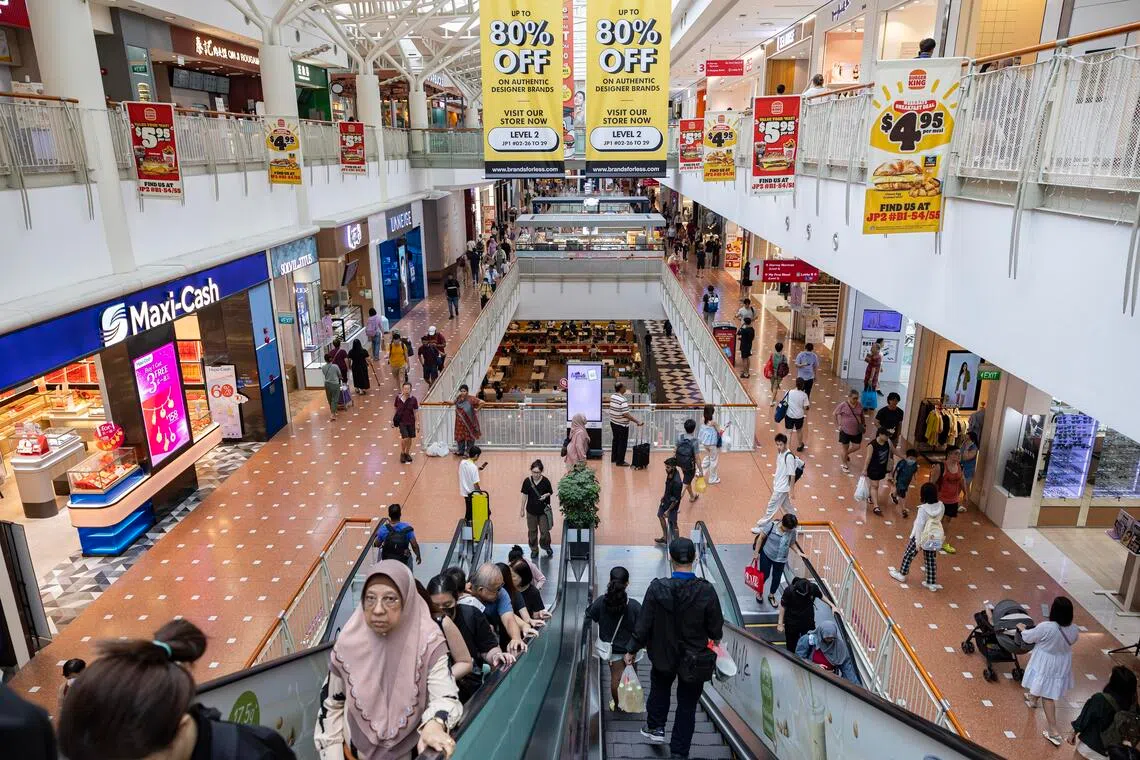Singapore retail sales rise 5.2% in August, more than expected, helped by CDC vouchers and tourism
Sign up now: Get ST's newsletters delivered to your inbox

Retail sales rose 5.2 per cent in August, more than the 4.6 per cent increase in July.
PHOTO: ST FILE
Follow topic:
SINGAPORE - Retail sales grew 5.2 per cent year on year in August, accelerating from July’s revised 4.6 per cent increase, data from the Department of Statistics released on Oct 3 showed.
The sector did better than expected, beating the 4.8 per cent growth forecast by analysts in a Bloomberg poll.
Encouraging retail sales numbers over two consecutive months – July and August – suggest that consumer sentiments and spending may be turning the corner after the softness in the first half, said Maybank economist Chua Hak Bin.
Stronger retail sales and tourism-related segments, including hotels, will help to partly cushion the blow from weaker exports in the third quarter, Dr Chua said.
Excluding cars and other vehicles, retail sales rose 4.6 per cent in August, more than the 3.9 per cent increase in July.
On a seasonally adjusted monthly basis, retail turnover grew by a smaller 0.5 per cent margin in August. Excluding motor vehicles, sales climbed 1.3 per cent month on month, against July’s 3.6 per cent growth.
Nine of the 14 retail industries saw year-on-year growth in sales:
Supermarkets and hypermarkets: 8.7 per cent
Motor vehicles: 8.9 per cent
Cosmetics, toiletries and medical goods: 8.1 per cent
Furniture and household equipment: 8.6 per cent
Recreational goods: 9.9 per cent
Watches and jewellery: 11.2 per cent
Computer and telecommunications equipment: 7.4 per cent
Optical goods and books: 8.4 per cent
Others: 1.6 per cent
In contrast, department stores and retailers of food and alcohol saw sales drop 6.5 per cent and 5.1 per cent respectively in August. Sales also fell 1.7 per cent at minimarts and convenience stores, 5 per cent at petrol service stations, and 1.4 per cent for apparel and footwear.
CDC vouchers likely drove supermarket sales in August, Dr Chua said. Distribution of CDC vouchers began on July 1 for seniors and July 22 for adults, and they are valid for redemption until December 2026.
Additionally, higher tourist arrivals and buoyant local sentiments from rising stock markets and property prices may be boosting discretionary spending, he said.
Singapore welcomed 1.6 million tourists in August, up about 4.5 per cent from a year ago.
Domestic consumption may have also picked up after the Government upgraded the full-year gross domestic product growth forecast to 1.5 per cent to 2.5 per cent, said OCBC Bank chief economist Selena Ling.
“Business and consumer confidence also improved with the trade deals struck by many countries with the United States, which resulted in the reduction of reciprocal tariffs,” said Ms Ling.
UOB associate economist Jester Koh said: “October retail sales may receive a boost from the Formula 1 Singapore Grand Prix, popular concerts and higher Chinese tourist arrivals amidst China’s October Golden Week holiday from Oct 1 to 8.”
However, slower wage growth, in addition to tepid hiring activity, could weigh on consumer sentiment and dampen discretionary spending for the rest of 2025 and into 2026, he added.
DBS Bank senior economist Chua Han Teng said while government support measures and a decline in interest rates will support the cash flows of Singapore households, global economic uncertainty will weigh on business hiring and wage increments, with local consumers likely to be prudent regarding discretionary spending.
The estimated total retail sales value in August was $4.3 billion. Of this, an estimated 13.1 per cent was from online retail sales, compared with the 13 per cent recorded in July.
August figures also show that sales of food and beverage services dipped 0.4 per cent in August on a year-on-year basis, reversing the 1.7 per cent growth in July.
On a seasonally adjusted basis, F&B sales declined 0.4 per cent in August 2025 compared with the previous month.
Year on year, restaurants saw a 3.2 per cent drop in sales compared with a year ago. However, food caterers saw higher turnover of 4.8 per cent, while sales for fast-food outlets rose 1.6 per cent.
Cafes, foodcourts and other eating places registered flat growth during this period.
The total sales value of food and beverage services in August was estimated at $1 billion. Of this, an estimated 26.3 per cent was from online sales, comparable to the 25.9 per cent recorded in July 2025.

